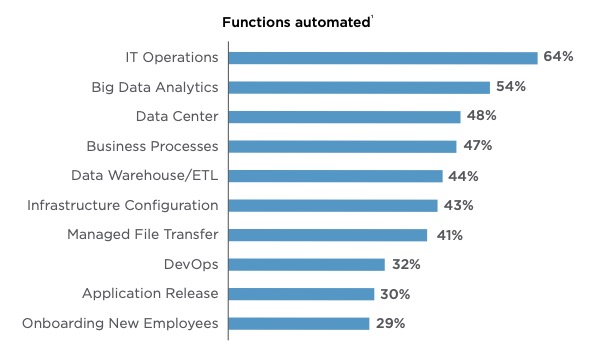Many businesses already have automation software. The problem is that the systems are disconnected. Having separate systems that don’t ‘talk’ to each other can limit the accessibility of data, known as data silos or islands of automation.
Often, when a department in a business encounters a problem, an automation solution is invested in to tackle that specific problem. If every department and location bought their own software, the number of separate solutions would mount-up over time.
Sound familiar? With 80% of companies using three or more automation platforms to fulfil separate business functions, it seems this is the current status quo for many organisations. However, with data islands presenting a number of issues, there’s a strong case to explore how they can be connected.
Where a large-scale enterprise business is going through digital transformation, it can be messy. You might have HR using different software from your logistics teams, for instance. Employing the solution at the time might bring benefits for those specific departments, but further down the line, problems with data disconnects will become inevitable.
In this guide, we’re looking at why automation silos are a problem and what solutions can be put in place to remedy them.
Where is automation employed the most?
Currently, IT operations are the most commonly automated department for businesses, closely followed by big data analytics, data centres and business processes. By understanding where automated processes and workflows are being used, you can more easily identify the threats or weaknesses this could pose for your business.

Source: https://docs.broadcom.com/doc/automatic-intelligence-ebook
How do islands of automation affect business growth?
A popular business term from the 1980s, data islands refers to a lack of integration between systems. Today, this also applies to automation solutions. One of the biggest problems is not having visibility into how tasks are being automated across your business. This often occurs when multiple tools operate in isolation from each other. At the very least, the isolation is inefficient. At its worst, the lack of cumulative visibility on data pipelines could result in SLA breaches or even a significant financial loss.
As an example, banks have been known to be fined millions where a system went down without sufficient IT risk processes to safeguard data and workload processes. This has a negative impact on business reputation.
For larger organisations, automation can be responsible for over one million tasks every day. The various systems are responsible for task and workload management, which means that if they encounter compatibility issues or system crashes, this could negatively impact productivity. The various systems are closely integrated and dependent on each other, and yet many data analysts don’t have access to the collective data to pinpoint what needs addressing as a matter of urgency.
As previously mentioned, SLA breaches can also be a result of one island not talking to the other. In fact, a survey found that, due to a lack of visibility on critical data, automation issues were one of the biggest causes of SLA breaches. You may think that the solution would be to reduce the reliance on automation, but without it, that could equally have a negative impact on productivity and force your business to hire more resources. Instead, having a single pane of glass view of any potential or current issues with the workload across your organisation could be the way forward.
In a report, 69% of companies stated that they lack the data to sufficiently optimise workloads; this was a result of silos decreasing data visibility. Providing accuracy and ensuring accessibility for your data analysts is key, which is where offering a single pane of glass is a crucial step.
Not being able to identify patterns also prevents business analysts from proactively planning for growth by forecasting changes in workloads.
What’s the solution?
How do you successfully manage complex workloads? With the right solution, you can reduce the cost and risk of workload problems.
Investing in a solution that bridges all your automation systems together with real-time data sharing can help. Instead of being contained or siloed in a single system, it ensures that information on your automation workflow systems is easily accessible and digestible.
Silos are only one part of the problem that a business might encounter. That’s why it’s important to understand the end-to-end environment.
Automic Automatic Intelligence integrates several automation engines and is becoming more affordable as a solution for businesses. In fact, businesses have reported that this solution can cut costs and time spent following up on problems by 80%.
The solution is compatible across all vendors and offers an easy-to-understand dashboard report. It also offers intelligent visualisation through a single pane of glass.
While many automated jobs might run on a mainframe, thousands of others might run on a home-grown distributed solution. If you have multiple systems with processing and dependency relationships, it’s important to be able to trace workloads and predict disruptions.
With many businesses having systems and updates that work 24/7, it’s vital to be able to detect weak or malfunctioning areas in the process or system before they become a problem.
An overarching automation solution can monitor the entire ecosystem. Using real-time data monitoring, it can flag issues that may arise based on previous outcomes. The solution can leverage several years’ worth of data to pick up patterns and trends, which can be communicated through dashboard reports that data analysts can review.
The biggest benefit of this solution is that businesses no longer need multiple monitoring systems. With just a single purchase, you can monitor all the workloads across your entire organisation. You’ll also eliminate the need to train employees on how to use multiple systems. In fact, if your organisation has Automic or AutoSys, you will already have access to this solution.
With the mainframe to microservices feature, you can build modules for specific functions and integrate them system-wide or where they’re needed. With the right system, you can also improve productivity by using a workload environment that becomes more efficient over time.
Drive more value from your automation systems
If you’re ready to add more value to your business, stay compliant and boost efficiency, an automation solution that provides a view across all your automated workload systems should help your company identify trends, gain visibility on performance or efficiency issues, and ultimately enhance productivity.
Speak to an expert automation integration partner at Ignite. We’ll take the time to get to know your pain points and how your business works to provide business automation software solutions. We can help get your integration set up in a fraction of the time of doing it in-house and work with your long-term goals.

